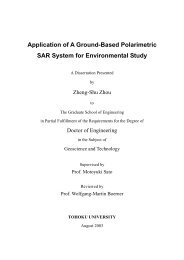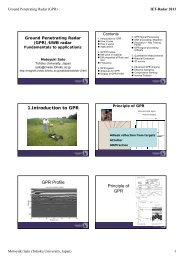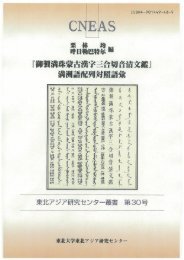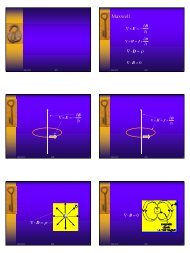Chapter 3: Vehicle-Mounted GPR System for Landmine Detection
Chapter 3: Vehicle-Mounted GPR System for Landmine Detection
Chapter 3: Vehicle-Mounted GPR System for Landmine Detection
You also want an ePaper? Increase the reach of your titles
YUMPU automatically turns print PDFs into web optimized ePapers that Google loves.
40 3. <strong>Vehicle</strong>-<strong>Mounted</strong> <strong>GPR</strong> <strong>System</strong> <strong>for</strong> <strong>Landmine</strong> <strong>Detection</strong><br />
Table 3.2: Definition of the confidence ratings.<br />
Ratings<br />
Criteria<br />
0 I am 100 % sure that there is nothing here<br />
25 It seems that there is something here<br />
50 I am 100 % sure that there is something here<br />
75<br />
I am not totally sure,<br />
but I would say the detected object seems to be a landmine<br />
100 I am 100 % sure that the detected object is a landmine<br />
3.5 Experimental Results<br />
An example of the experimental result is shown here. The measurement was<br />
carried out at a sand pit in the <strong>GPR</strong> Lab., Tohoku University, Japan. The targets<br />
were landmine models of Type72 and PMN2 shown in Fig. 3.12, and a mine-like 3<br />
stone buried as Fig. 3.13. They are buried at a depth of 2 cm, and the landmine<br />
model PMN2 is buried vertically. The soil is dry sand mixed with gravels whose<br />
diameters are around 2 cm. The <strong>GPR</strong> antennas were scanned by an x-y stage<br />
(Device Co., Ltd., Japan) with a velocity of 100 mm/s as shown in Fig. 3.14. The<br />
measurement interval is 30 mm in both x and y directions.<br />
The raw time domain data acquired by VNA #1 (inner pair) is shown in Fig. 3.15<br />
as a horizontal slice at a time of 2.4 ns, which corresponds at a depth of about 2 cm.<br />
The three targets are visible in this profile, however also clutter can be seen and the<br />
responses from the targets are not so clear. Thus, they cannot be recognized without<br />
a priori knowledge. Fig. 3.16 shows vertical and horizontal slices of the processed<br />
data at x =110 cm and at a depth of 2 cm. The three targets are clearly imaged and<br />
they have obviously different shapes and dimensions to clutter imaged at left on the<br />
horizontal slice. Note that the depth in the vertical slice is defined from the tip of the<br />
antennas, thus the ground surface is imaged at a depth of 10 cm. The measurement<br />
was a blind test, i.e. the operator did not know the types, positions, depths, and<br />
numbers of buried objects prior to the measurement. From the image, the operator<br />
3 The term mine-like object is defined as an object whose shape and dimension resemble that of a<br />
landmine.








